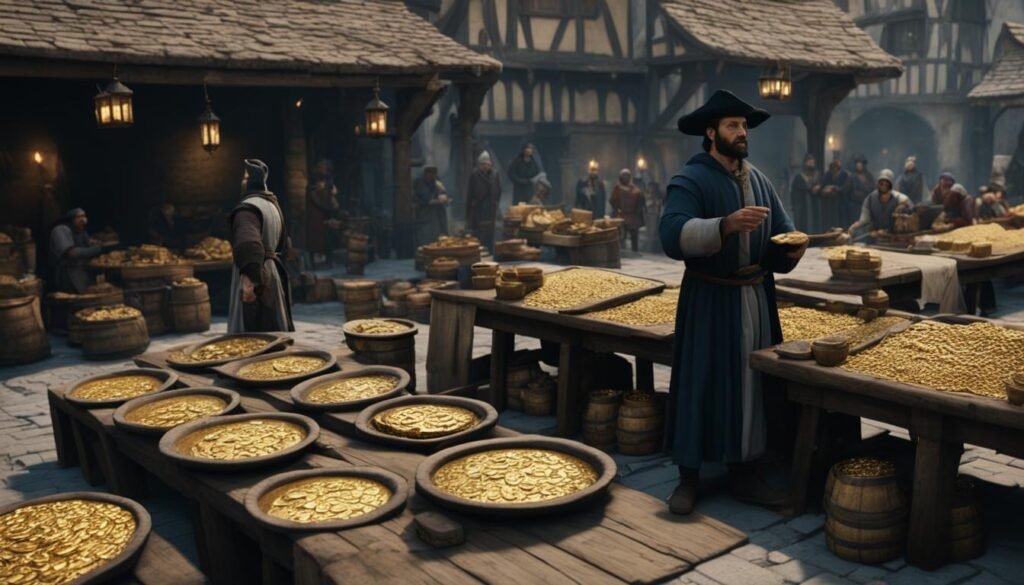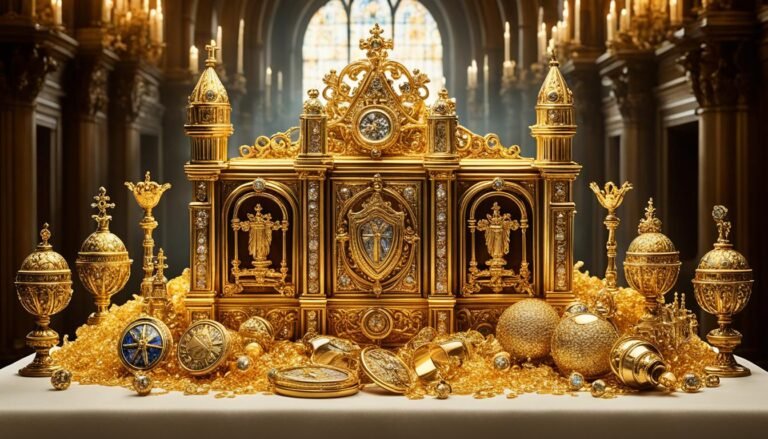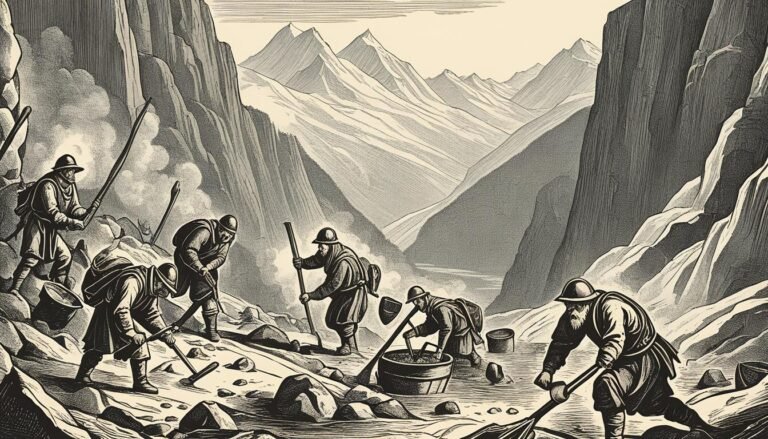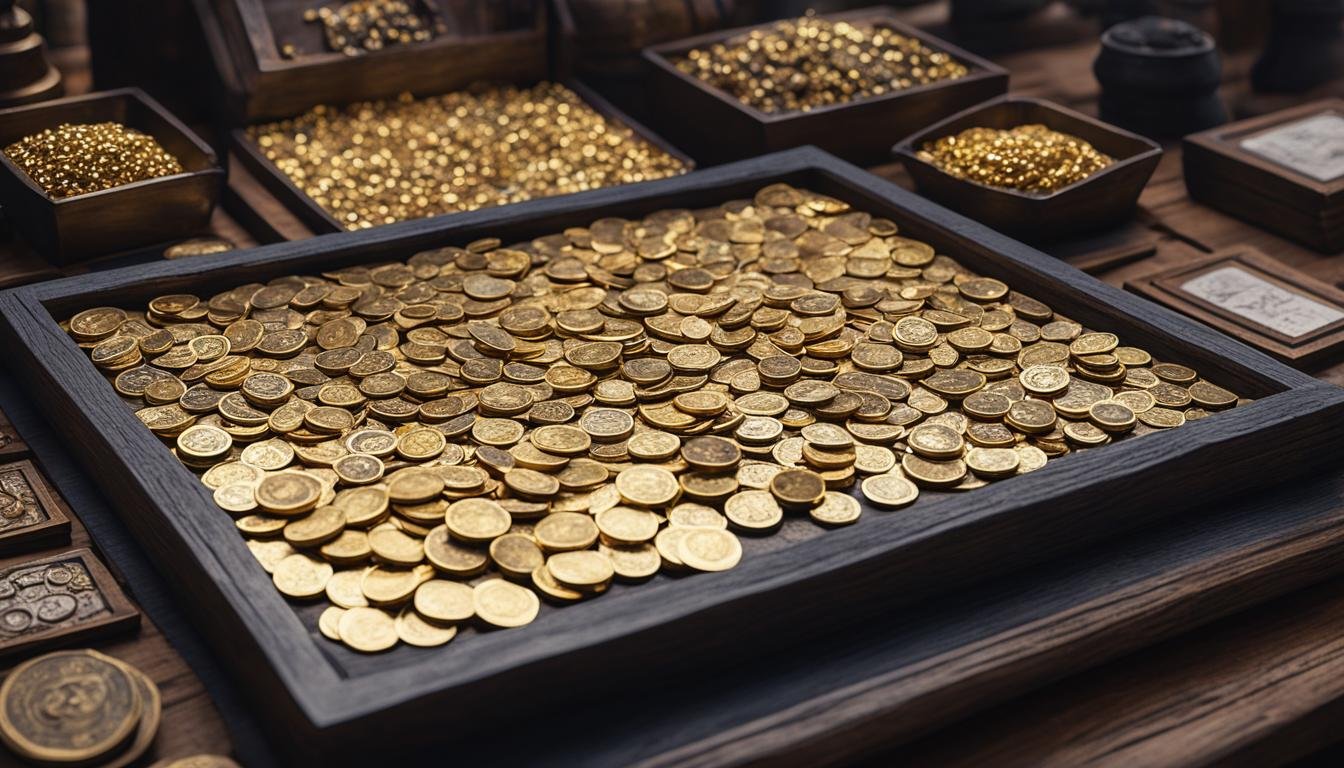Throughout the annals of history, gold has unfailingly mirrored the complexities of economic development and societal transformation.
In the tumultuous era following the fall of the Western Roman Empire, the invaluable luster of medieval gold currency shone brightly as a beacon of stability in the burgeoning feudal societies of Europe.
With the ascent of nation-states in the High Middle Ages, the precious metal soared in its significance, entrenching itself as the fulcrum around which the economies revolved.
Far surpassing a mere medium of transaction, the gold economic role during the medieval period molded the parameters of power and prosperity, knitting itself indelibly into the fabric of European advancement.
Key Takeaways about Gold in Medieval Europe
- Gold’s pivotal role in replacing the barter system with monetized economies in medieval Europe
- Influence of gold on the societal structure and political power within feudal societies
- Gold’s intrinsic value and its impact on the development of a commoditized and standardized economic framework
- The philosophical and cultural reverence afforded to gold, reflecting its status as the most precious of metals
- The evolution of Europe’s financial systems markedly shaped by the utilitarian and symbolic facets of gold
Gold’s Status and Symbolism in Feudal Societies
In the tapestry of medieval Europe, the glimmer of gold was more than a mere adornment; it served as a defining element of status and spirituality.
This precious metal became an emblem of both affluence and divine benevolence, intricately woven into the fabric of feudal societies. Its opulence was on full display in the regalia of monarchs and in the sacred precincts of cathedrals, symbolizing the unison of earthly power and celestial approval.
Reflection of Wealth and Divine Favor
The symbolism of gold in medieval feudal societies went beyond tangible riches; it was a visible sign of spiritual distinction and favor from the heavens.
Royalty and the church vied in the ostentatious display of gold, each affirming their stature and closeness to the divine. To possess gold was to signal a special place in the societal hierarchy, one ordained by higher powers and recognized by all strata within the medieval world.
Ninth Century Philosophers On Gold’s Purity
Gold, in its resplendent purity and incorruptible essence, is the noblest of metals, unfading and untouched by the passage of time.
Ideas such as these, put forth by influential minds like the polymath Geber, highlighted gold as the embodiment of perfection and virtue. This gold virtue symbolism permeated medieval thinking, cementing the metal’s status as a paragon of value and a measure by which all else was judged.
| Philosopher | View of Gold | Impact on Society |
|---|---|---|
| Geber | Gold is the perfect metal, symbolizing divine grace and incorruptibility. | Elevated gold’s stature beyond the material, fortifying its connection with divine favor. |
| Thomas Aquinas | Gold holds intrinsic value, reflective of heavenly glory. | Justified the accumulation of gold as a reflection of the celestial order within the church and nobility. |
| Albertus Magnus | Gold’s splendor is a mirror to the wisdom of the Creator. | Amplified the use of gold in religious iconography and artifacts, reinforcing its sacred connotations. |
The rich interplay between gold’s luster and its representations of both worldly success and otherworldly sanctity underscored the complex narrative of medieval wealth representation. Thus, in the annals of feudal societies, gold remained not just a currency of commerce but, more enduringly, a currency of power and divine recognition.
Quiz: The Role of Gold in Medieval Europe
Monetary System Evolution From Barter to Gold Coins
The collapse of the Western Roman Empire triggered a period of economic disarray, leaving societies to revert to the rudimentary medieval barter system. Items and services were traded without a standard currency, a method that while functional, was limited in scope and efficiency.
This system laid the groundwork for a transformative era in commerce, leading to pivotal developments in the way goods were exchanged and paving the way for significant advancements in monetary policies.
The Decline of The Roman Empire and the Emergence of Coinage
As the dust settled following the dissolution of Roman governance, the necessity for a more robust and scalable economic system became apparent. It was during this time of transition that regions in Europe began to explore the concept of coinage, laying the foundation for the coinage evolution we’ve come to understand in historical contexts. Precious metals were identified for their universality in value, with particular emphasis on the durability and desirability of gold.
The Advent of the Feudal System and the Role of Gold
With the feudal system’s rise to prominence, a framework was established that promoted the standardization of currency, heavily favoring the inherent value of gold. The adoption of gold as a primary medium for trade witnessed the shift from a barter-centered economy to one driven by monetary exchange.
Gold coins began to embody wealth and power, becoming pivotal in the expansion of trade and the increasing complexity of the European economy.
Throughout this period, the reliquary of coinage magnified in importance with the influx of gold coins, generating a wave of prosperity amidst emerging nation-states. Their economy, once fettered by the constraints of barter trade, was now embarking on a new trajectory of financial sophistication and integration.
The extensive impact of this transition is underscored by the intricate network of trade routes and the societal changes it prompted. Coinage evolution was not merely a shift in commercial activities; it represented a significant cultural and socio-economic transformation that was central to the progression from the medieval ages to modern economies.
Gold Mining Techniques and Technologies of the Medieval Era
The evolution of medieval gold mining and technological advancements fundamentally shaped the European economies during the Middle Ages. The fervent quest for gold led to various innovations that improved the efficiency of extraction and processing, making the precious metal more accessible than ever before.
Among the myriad of developments, some notable technological advancements included the introduction of hydraulics for prospecting, water wheels for ore grinding, and novel ways of ventilating mines. These innovations were not solely the products of medieval Europe but were also influenced by the exchange of knowledge from other regions, including the Islamic Golden Age and, possibly, Eastern civilizations.
- Hydraulic action to erode gold-bearing rocks
- Introduction of the arrastra to crush and retrieve gold
- The use of sluices and settling basins to separate gold particles
As medieval gold mining techniques continued to progress, so did the means to increase production. The implementation of these techniques was instrumental in fostering a robust growth in the gold supply, essential for financing burgeoning economies and underpinning the era’s monetary systems.
Through relentless innovation and the amalgamation of global mining practices, medieval Europe transformed gold extraction into a cornerstone of its socio-economic development.
It wasn’t just the mining processes that saw improvement, metallurgical methods also underwent transformation. The amalgamation process, which uses mercury to extract gold from ore, became widespread, significantly increasing yields and efficiency in gold production.
With each passing century, the Middle Ages laid the groundwork for Europe’s golden era of exploration and economic prowess, all fostered by advancements made in the pursuit of one of the world’s most sought-after metals.
The Influence of Chinese Gold Processing Knowledge
The cross-fertilization of Chinese metallurgical techniques with European processes dramatically advanced the methods of gold purification in medieval Europe. The profound impact of these practices is encapsulated in the works and philosophies of scholars like Geber, who is celebrated for his alchemical contributions that were likely influenced by the East.

Through intricate trade routes and the exchange of knowledge, the meticulous Chinese approaches to metal work were slowly assimilated into the European metallurgical repertoire. These contributions facilitated numerous advances within the era, particularly within the realm of gold refinement, impacting the economic vigor and cultural opulence medieval Europe is renowned for.
- Gold Purification Methods: The integration of Chinese methods improved the purity and quality of European gold.
- Technological Advancements: Metallurgical innovations were adopted, enhancing extraction and processing efficiency.
- Industrial Implications: Greater purity in gold production helped facilitate trade and assert monetary confidence.
While the true scope of Chinese influence on European metallurgy remains a subject of scholarly exploration, the period evidences a remarkable leap in gold purification sophistication – evidently inspired by foreign mastery in the craft.
In essence, the transcontinental dialogue in metallurgical proficiency not only revolutionized European techniques but also irrevocably changed the socio-economic landscape through the surge in gold availability and trade. These interactions serve as a testament to the era’s globalization that often is overshadowed by subsequent historical narratives of economic exchange and cultural borrowing.
Gold Medieval: Myth and Reality in Literature and Exploration
The enthralling tales of Marco Polo’s explorations during the 13th century served as a bedrock upon which European desires for gold were founded. This period witnessed an unprecedented intertwine of literature and reality, creating a tapestry rife with legendary cities of gold and uncharted treasures.
Marco Polo’s Accounts and the European Gold Imaginary
Marco Polo’s odyssey, particularly his experiences in the court of the Mongol ruler Kublai Khan, left a lasting impression upon the European imagination. In detailed descriptions of opulence in the East, he contributed to the inception of the gold myths medieval societies began to weave. His chronicles, perceived as both investigations and fables, blurred the lines between real gold accumulation and the lore surrounding it.
These narratives drove an insatiable appetite for exploration among Europeans, galvanized by the sheer possibility of discovering analogous fortunes. The desire to replicate Marco Polo’s encounter with wealth in distant territories is evident in the expeditions that shaped the following centuries.
The Connection Between Myth and Overseas Gold Expeditions
Gold, with its irresistible lure, became the cornerstone of countless voyages. The legend of El Dorado, a city believed to be laden with gold, is notably emblematic of how belief and ambition can fuel exploration.
Expeditions in pursuit of legendary wealth like this often returned with immense gold reserves, shaping not just economies back home, but also the future of global exploration and conquest.
| Myth | Explorer | Reality |
|---|---|---|
| El Dorado | Francisco de Orellana | Introduced the Amazon River to European maps |
| King Prester John’s Kingdom | Marco Polo | Inspired journeys to Asia and Africa, expanding trade routes |
| Cibola, the Seven Cities of Gold | Francisco Vázquez de Coronado | Expanded European geographical understanding of North America |
Thus, the fascination with Marco Polo’s ventures and the allure of medieval gold myths significantly influenced the trajectory of European expansion and acquisition. These legends became integral to the European collective consciousness, prompting a series of intrepid explorations that sought the reality behind the myths.
The Institutional Control of Gold: Mints and Crown Policies
The governance of gold in the medieval era was a significant affair, often conducted within the imposing walls of medieval mints. The production and quality of gold coinage were chief concerns for rulers, both as indicators of sovereign might and as tools of fiscal policy.
By regulating the intricate processes of coin production, royal authorities exercised a form of economic control which was as much about power as it was about pragmatism.
Centralization of Coin Minting in Local Mints
In a strategic shift from dispersed minting practices, the centralization of coin production became a means for the crown to fortify royal coinage regulation. Such consolidation facilitated the standardization of coinage – a critical factor for a realm aspiring to economic homogeneity.
Royal edicts determined not just who could mint coins but also enforced uniformity in weight and fineness. This move also served to curtail counterfeit minting, which was rife at the time and a thorn in the crown’s side.
The Impact of Crown Policies on Gold Coin Circulation
The realm’s coffers were closely tied to the circulation of gold coins. Through the imposition of seigniorage – a form of tax levied on coins by the monarch – the process was deftly used to shore up royal finances.
Regulation went beyond mere financial gain; it was an extension of monarchal influence, a subtle reminder of whom all wealth ultimately served. A cohesive circulation of coinage was thus both a practical and symbolic bastion of the reigning monarch’s dominance over the economy.
Gold and Global Trade: Europe’s Monetization of the World
The ascent of medieval global trade was intrinsically tied to the establishment of the gold standard international exchange. As a universally accepted medium of value, gold provided a cohesive element in the monetary policies across different world markets.
Europe’s pursuit of gold not only fueled its own economic growth but also laid the groundwork for a monetized global marketplace where goods, ideas, and cultures intersected like never before.
The expansive trade networks reached from the silk and spice routes in the East to the bustling markets of Venice and Genoa. With gold holding sway as the fundamental unit of exchange, European merchants, bankers, and monarchies could wield influence well beyond their borders, cementing the continent’s position in medieval commerce.
Here is a closer look at the key regions and commodities involved in this vast exchange system:
| Region | Commodities Traded | Gold Exchange Role |
|---|---|---|
| Africa | Ivory, Gold, Exotic Animals | Direct source of gold imports into Europe |
| Middle East | Spices, Fabrics, Pearls | Transit point for Asian goods and value standardization |
| Asia | Silk, Porcelain, Spices | European gold used to secure luxury items |
| Europe | Manufactured Goods, Wool, Silver | Gold standard driving intercontinental trade |
As Europe ambitiously engaged with other continents, the gold standard played a crucial role in solidifying trust and ensuring the fluency of these expansive trade ventures. Historians and economists often herald this period as the dawn of financial globalization, with gold functioning as the steadfast pillar of complex international commerce.
The Advent of Gold Currency: From the Gold Penny to the Noble
Evolution is inherent in the essence of civilization, and such was the case when medieval England witnessed the momentous introduction of gold coinage. This pivotal transition from the utilitarian silver to the illustrious gold currency not only echoed the affluence of the era but also set a new economic precedent.
Predominantly, the gold penny, initially doled out for alms in the mid-13th century, laid the foundation for a broader spectrum of denominations including the renowned noble and its successors.

English Gold Coins and Their Valuation
The minting of gold currency was a statement of prosperity and stability, as these coins bore witness to England’s burgeoning economic prominence. Key players in this monetary renaissance were the leopard, the noble, and later, the angel and rose noble, each emblazoned with regal iconography and steeped in worth.
The table below catalogs the progression of medieval English gold currency, encapsulating both their valuation and their contribution to the rich tapestry of England’s numismatic heritage.
| Coin | Introduction | Value | Metal Content | Cultural Significance |
|---|---|---|---|---|
| Gold Penny | 1257 | 20 Silver Pennies | 22-karat Gold | Charitable Dispensation |
| Leopard | 1344 | 3 Shillings | 23.5-karat Gold | Symbol of Edward III’s Claim to the French Throne |
| Noble | 1344 | 6 Shillings 8 Pence | 23-karat Gold | Regal Power and Trade |
| Angel | 1464 | 6 Shillings 8 Pence | Metallon Regale | Good Fortune and Health |
| Rose Noble | 1464 | 10 Shillings | Refined Gold | Wealth and Splendor of the Tudors |
The Transition from Silver to Gold Coins and Its Implications
The gradual shift from silver to gold as the preferred medium of exchange carried profound implications. Affluence, once gauged by quantities of the lighter-toned metal, was now reckoned by the possession of these smaller, yet more valuable, golden artifacts.
The introduction of gold coinage fostered an economic reorientation; it heightened the liquidity of large sums and facilitated international trade, forever transforming the landscape of wealth and transaction within medieval society.
Medieval Banking and the Rise of Non-Coin Currency
The medieval era witnessed a significant shift in the European economy, as traditional methods of trade and commerce expanded to include innovative financial practices.
One of the defining characteristics of this period was the development of a medieval banking system that started to rely on non-coin financial instruments. Such budding fiscal sophistication made way for more intricate and large-scale financing and trading activities, which were essential to the economic growth across the continent.
A central figure in this transformative financial landscape was the Jewish community, whose contribution to banking practices was indelible.
The Role of the Jewish Community in Money Lending
Money lending by the Jewish community filled a vital niche in medieval Europe’s economy. With Christians often barred from charging interest on loans due to religious prohibitions, Jewish moneylenders became indispensable in providing credit, thereby facilitating business and trade. This historical cooperation and trust laid the groundwork for more formalized banking functions and credit structures that were to emerge.
Another aspect that catalyzed the evolution of banking during the Middle Ages was the advent of a money of account system that eased trade and taxation.
Units of Account: Shillings, Pounds and the Velocity of Circulation
The utility and efficiency of the medieval economy were greatly increased by the introduction of non-coin currency units such as shillings and pounds. These were abstract units that could be counted and accounted for without the physical exchange of coins, accelerating the velocity of circulation and enabling large, complicated financial dealings synonymous with vigorous mercantile activity and faster capital turnover.
| Financial Instrument | Function | Impact on Trade |
|---|---|---|
| Money Lending Services | Provided credit for trade and personal expenses | Enabled merchants and individuals to expand enterprises & overcome temporal shortages |
| Shillings, Pounds, Marks, Ora | Units of account promoting abstract transaction system | Transactions became quicker, facilitating the rapid movement of goods and services |
| Promissory Notes & IOUs | Predecessors to modern-day cheques and banknotes | Reduced risk of theft and loss; Simplified long-distance trade |
The medieval banking system not only supported the burgeoning economy but also planted the seeds for the modern financial systems we recognize today. The Jewish community’s integral role and the creation of non-coin financial instruments were both crucial in shaping the financial sophistication that pushed Europe towards the Renaissance and beyond.
Countering Forgery and Coin Clipping in Medieval Europe
The integrity of medieval coinage was paramount to maintaining a stable monetary system. During this period, European rulers and mints faced a constant battle against anti-counterfeiting measures. Illicit practices such as coin clipping—trimming small amounts of precious metal from the edges of coins—threatened the value and trust in the currency. To combat these acts and restore medieval coinage integrity, a variety of strategies were implemented by the authorities.
Among the notable innovations was the introduction of a new coin design known as the long cross penny. The cross, which extended to the edge of the coin, made it immediately apparent if pieces of the coin were clipped off. This clever but simple tactic was an early form of anti-counterfeiting technology that showcased the dedication to maintaining the credibility of the realm’s currency.
Further regulatory measures included:
- Strict punishments for those caught counterfeiting or clipping coins—often acts punishable by death or mutilation.
- Regular renewal of coinage, calling in old coins to be reminted to curb the circulation of clipped coins.
- Edicts specifying the acceptable wear and tear on coins, beyond which they must be exchanged or reminted.
These actions taken by medieval institutions reflected a sophisticated and proactive approach to anti-counterfeiting measures, well ahead of their time. The issue of maintaining medieval coinage integrity was not only a financial concern but also a matter of national pride and sovereignty.
By analyzing the historical enforcement of these regulations and the circulation of coins from this era, it becomes evident how seriously medieval societies took the threat of economic instability due to fraudulent coins—an issue that resonates just as strongly in today’s digital economies.
The Social Hierarchy of Wealth: Nobility’s Income from Gold
The medieval wealth distribution was markedly skewed towards the upper echelons of society, particularly the nobility. Lords and barons controlled substantial landholdings, which allowed them to amass wealth through various means, including taxation, agricultural production, and trade. However, it was their income from gold that truly exemplified their dominance and reinforced the social stratifications of the time.
During the medieval era, nobility gold revenues stemmed not just from their own mines and acquired treasures but also through their entitlement to royal dispensations. Gold was a potent symbol of power—and when it flowed into the coffers of the nobility—it became a clear statement of their unrivaled status. Let us delve into how gold impacted the income and influence of medieval noble families.
| Source of Gold Income | Description | Impact on Nobility’s Wealth |
|---|---|---|
| Royal Grants | Gold given by the monarch for service or favor. | Increased directly the noble’s affluence and clout. |
| Landholdings | Collection of taxes and dues in gold from tenantry. | Provided a steady, reliable stream of wealth. |
| Commerce and Trade | Investment in merchant ventures often returned in gold profits. | Enabled diversification and expansion of noble estates. |
| Marriage Alliances | Dowries and political unions brought gold as a part of agreements. | Strengthened family ties and spurred wealth accumulation. |
| Looting and Tribute | Gold acquired through military conquest or by way of submission from foes. | Fortified a noble’s status and resource command. |
Within the medieval wealth distribution, no stone was left unturned in the quest for gold—the ultimate symbol of affluence and prestige. It was common for the nobility to display their wealth ostentatiously, wearing elaborate jewelry and adorning their homes with precious metals. In essence, these material representations of wealth were not merely personal luxuries but public declarations of their societal rank and influence.
Historically, the accumulation of gold revenue by the nobility not only informed their contemporaries of their status but also passed a message of power and influence down to posterity.
The financial strategies and acute awareness of the nobility in managing gold revenues highlight a sophisticated understanding of wealth preservation and augmentation. Medieval nobility knew that gold was not just a route to immediate power but also a means to secure a legacy for generations to come—a testament to the enduring significance of gold in shaping human history and society.
Gold Hoards and the Concept of Treasure in Medieval Times
The medieval era’s relationship with gold is punctuated by the discovery of sizeable hoards, providing a window into the period’s socioeconomic dynamics. Among the most notable of these is the Fishpool hoard, unearthed in England, which offers a vivid snapshot of the past and serves as a critical economic indicator.
The contents of such hoards have proven integral to understanding medieval gold reserves and the economic patterns of the time.

The Discovery of the Fishpool Hoard and its Historical Context
Found in 1966 in Nottinghamshire, the Fishpool Hoard dates back to the latter half of the 15th century, a tumultuous era marked by the Wars of the Roses. This treasure trove consists of of coins, jewelry, and other valuables, thought to have been hastily secreted away during a time of crisis. The hoard’s composition provides insight into wealth storage practices and the economic climate of the period.
Medieval Hoards as Indicators of Economic Patterns
Hoards like the Fishpool discovery are more than just buried treasure; they are historical ledgers that record moments of peril and economic behavior. The act of hoarding sizeable quantities of gold and valuables is often a tell-tale sign of instability.
Yet, these hoards are invaluable for reconstructing medieval economic indicators, such as circulation patterns of coinage, inflation rates, and the financial impact of warfare and plague.
| Hoards | Context | Significance |
|---|---|---|
| Fishpool Hoard | English Wars of the Roses | Reflection of conflict-driven wealth storage |
| Cuerdale Hoard | Viking settlement in England | Evidence of early medieval trade and wealth accumulation |
| Staffordshire Hoard | Anglo-Saxon England | Insight into military armament and artwork of the period |
Cultural and Religious Attitudes Toward Gold Accumulation
In the tapestry of medieval society, the convergence of medieval ethical perspectives and gold religious significance weaves a complex narrative about the accumulation of wealth. Cultural and religious norms dictated a delicate dance between the allure of gold and the moral compass of the time.
The Christian church, wielding substantial influence, often preached the virtues of modesty and charity, casting a critical eye on the amassed riches and opulence that gold represented.
While gold was a symbol of divine grace and favor, an excessive fondness for it could invite accusations of greed and corruption. For many, the pursuit of wealth was to be balanced with spiritual duties, a sentiment encapsulated in the era’s art, literature, and legal codes.
Piety and wealth were not mutually exclusive, but the church sought to steer the hearts of the wealthy towards humble generosity.
The love of money is the root of all evil; yet it is such a necessary evil that we cannot get on without it in the world. – Matthew Paris, English Benedictine monk, 13th Century
- Attitudes toward gold in regard to Almsgiving and Charity
- Challenges to the Church’s stance on Wealth and Avarice
- The Dichotomy of Wealth: Between Worldly Power and Spiritual Salvation
- Gold in Religious Artifacts: Object of Veneration and Worship
Thus, in the heart of medieval Europe, gold was not merely a measure of wealth but a nexus of social expectation and spiritual reflection. The shared beliefs and values of the time crafted an ethical framework within which gold was simultaneously treasured and scrutinized.
‘Gold Fever’ and Its Impact on Medieval Society and Economy
The historical footprint of the gold rush phenomena is deeply etched into the fabric of medieval society. Far from being a purely modern occurrence, the insatiable gold obsession of the Middle Ages spurred entire populations into action, altering trade routes, accelerating the exploration of distant lands, and reconstructing entire economies devoted to the precious metal.
Early Accounts of Gold Rushes Preceding the New World Discovery
Before the age of Columbus, the allure of gold had already driven numerous expeditions in search of mythical lands such as El Dorado. These expeditions, which were the precursors to the more famous gold rushes that followed in the New World, indicate a long-standing tradition of gold obsession.
The tales of rich gold lands in Brazil and the feverish quest for treasure had already begun to influence European discourse and policy, manifesting in sovereign backing of exploratory voyages.
The Economic Consequences of a Society Obsessed with Gold
Gold fever had widespread societal effects in medieval Europe. At times, it contributed to economic prosperity and the development of new trade networks, reinforcing the gold standard as an instrument of international exchange.
However, it also caused severe inflation, created economic bubbles, and led to a distortion of labor markets as craftsmen, farmers, and even soldiers abandoned their posts to search for gold.

In analyzing the societal effects of gold obsession, one cannot overlook the long-term impact on population dynamics, migration patterns, and even shifts in power structures. The relentless pursuit of gold drew people to new territories, establishing new communities, and at times, depopulating others.
The gentry and merchant classes especially capitalized on the opportunities presented by ‘gold fever,’ amassing wealth that would influence social hierarchies for generations to come.
Gold’s Role in Medieval Warfare and Diplomacy
The precious luster of gold not only symbolized wealth and power but also served as a pivotal element in the conduct of medieval warfare and the delicate art of maintaining international relations. The importance of gold in medieval warfare was multifaceted, ranging from financing large-scale military campaigns to ensuring the loyalty of allies with gifts of gold.
Diplomatic exchanges often relied on gold to negotiate terms or secure peace, making it the language of power and persuasion. The strategic value of gold was so profound that it could decisively influence the outcome of sieges and standoffs, delineating victory or defeat in the annals of history.
Financing Wars: Gold as a Strategic Resource
Military endeavors in medieval Europe demanded considerable resources, with gold fulfilling the role of a universal facilitator. To equip and sustain armies, leaders leveraged their gold reserves, procuring weaponry, armor, and provisions.
The ability of a ruler to muster a formidable force was inextricably linked to the size of their treasury – a war chest brimming with gold equated to extended campaigns and potentially conquered territories.
Diplomatic Gifts and Ransoms: The Currency of Kings
Royalty and nobility often used gold as a potent tool for diplomacy. Lavish gifts of gold served to forge alliances, reward loyalty, or sway the favor of foreign dignitaries. During tense times, gold offered as a ransom could retrieve valuable hostages or procure armistices, thereby averting further conflict.
This metallic currency held sway over the grand board of medieval politics, with its gleam reflecting the power dynamics of kingdoms and empires.
Gold’s dual role in both military and diplomatic arenas is encapsulated by the following accounts, which illustrate the depth and breadth of its influence:
| Event | Role of Gold | Outcome |
|---|---|---|
| Financing Campaigns | Gold served as a crucial asset to fund and equip armies. | Empires expanded or were defended against invaders. |
| Sealing Treaties | Gold gifts were instrumental in sealing pacts and treaties. | Strategic alliances were formed, stabilizing borders and trade routes. |
| Ransoming Nobility | Gold was the preferred medium for exchanging hostages or captives. | Lives were spared and political stability was often restored. |
The ubiquitous reliance on gold underpinned a crucial period wherein the foundations of modern statecraft were forged. From the clang of swords to the quieter whispers within regal courts, gold served as the silent arbitrator of medieval destiny.
10 Interesting Facts about the role of gold in Medieval Europe
- Gold was a symbol of wealth, power, and prestige in medieval society. It was used to decorate castles, create crowns for royalty, and mint coins.
- Gold coins were a crucial part of medieval economies, used for trade and as a standard currency. Their value was based on weight and purity.
- Venice and Florence were major hubs of gold trading in medieval Europe, with merchant guilds controlling much of the trade.
- Gold was moved along popular trade routes like the Silk Road and across the Mediterranean Sea.
- Medieval financial accounts often measured money in units called “libra,” which represented a certain amount of gold.
- Goldsmiths played important roles in medieval society, crafting jewelry and religious items, minting coins, and even acting as early bankers by storing wealth for clients.
- Churches and monasteries were often decorated with golden altarpieces and artifacts, symbolizing divine presence and prosperity.
- The Islamic empires of North Africa had a high demand for West African gold, which was used for manufacturing goods and minting coins.
- Two-thirds of the gold circulating in the medieval Mediterranean at the trade’s peak came from West Africa.
- The gold-to-silver ratio fluctuated in medieval Europe. In Viking-era Scandinavia, for example, it went from 20:1 to 12:1, possibly due to an influx of silver.
Conclusion
As we peer into the annals of our past, the story of gold in medieval Europe unfolds like an intricate tapestry, laden with transformative power. From the shadowy turmoil of the Dark Ages to the burgeoning dawn of modernity, gold was not merely a metal but a pivotal architect in Europe’s economic transformation.
Interwoven into the fabric of societal evolution, its luster captivated noble ambitions, financed profound explorations, and bridged the chasms of international trade.
Reflecting on Gold’s Enduring Legacy in Europe’s History
Gold’s historical legacy is illustrated in the political fortifications it financed, the cultural revolutions it underscored, and the economic stability it ensured. The substance of kings and the target of explorers, it fueled the aspirations of countless adventurers setting sail in pursuit of fortune, forever altering the geographical understanding of their world.
Its enduring allure is embed within Europe’s edifices, monuments to the indelible mark that gold pressed upon the continent’s history.
The Transformative Power of Gold from the Dark Ages to the Dawn of Modernity
The passage from bartered goods to coinage marked by the glint of gold heralded the onset of a transformative era. Gold, as a crucial catalyst, propelled a nascent Europe towards complex economic systems and a newly defined social stratification. The thread of gold runs steadfast through the tapestry of time, enshrining the metal’s place at the heart of power, innovation, and economic propulsion.
Its story is the saga of Europe itself – ceaselessly evolving, perpetually enchanting.
FAQ about The Role of Gold in Medieval Europe
Why was gold so important in the Middle Ages?
Gold was highly valued in the Middle Ages for several reasons:
- It was a symbol of wealth and power
- Used for currency and trade
- Prized for its beauty in jewelry and decorative arts
- Considered sacred in religious contexts
- Used in medicine and alchemy
What was gold used for in Europe?
In medieval Europe, gold had various uses:
- Minting coins
- Creating jewelry and ornaments
- Decorating religious artifacts and manuscripts
- Gilding architecture and sculptures
- As a medium of exchange in international trade
What was the role of the goldsmith in medieval times?
Goldsmiths in medieval times had several important roles:
- Crafting jewelry, religious items, and decorative objects
- Minting coins for local authorities
- Acting as early bankers, storing wealth for clients
- Assaying gold to determine its purity
- Training apprentices in the craft
What were the most important metals in medieval Europe?
The most important metals in medieval Europe were:
- Gold
- Silver
- Copper
- Iron
- Lead
- Tin
- Mercury (also known as quicksilver)
Was gold discovered before iron?
Yes, gold was discovered and used long before iron. Gold has been known to humans since prehistoric times, while iron working began much later, around 1200 BCE.
Which 7 metals were known to the ancients?
The seven metals known to the ancients were:
- Gold
- Silver
- Copper
- Iron
- Lead
- Tin
- Mercury
These metals were known and used in ancient civilizations and were often associated with celestial bodies in alchemy and early astronomy.
What was the role of gold in the monetary system evolution during medieval Europe?
Gold’s inherent value led to its adoption as currency, marking the transition from a barter system to a monetized economy. The decline of the Western Roman Empire brought about a shift towards gold coins, which facilitated more structured and complex financial systems in Europe.
How did gold represent wealth and divine favor in feudal societies?
In medieval feudal societies, gold symbolized not only material wealth but also divine grace, representing the highest echelons of power and spiritual purity. It was commonly associated with royalty and the church, indicating favor in the eyes of God.
Can you describe some technological advancements in gold mining during the medieval era?
The Middle Ages saw significant advancements in mining techniques and technologies for gold, including more efficient extraction and processing methods. Innovations, influenced by global knowledge and local ingenuity, improved geological and metallurgical practices, increasing the production and availability of gold.
How did Chinese metallurgical techniques influence medieval European gold refining?
European gold refining during the medieval era was influenced by knowledge from China, where philosophers and scientists brought forward understanding that complemented European practices. This sharing of information contributed to the enhanced refinement of gold processing.
What is the historical significance of Marco Polo’s accounts for European gold exploration?
Marco Polo’s accounts of the immense riches in distant lands stirred European imaginations and ambitions regarding gold. These concepts and the mythical city of El Dorado fueled exploratory voyages and subsequent gold rushes, transforming the economic landscape of Europe.
How did the centralization of coin minting reflect the crown’s authority?
The transition from numerous local mints to a centralized coin-minting mechanism reflected the crown’s control over minting processes and coinage standards. This centralization allowed monarchies to maintain economic stability and generate revenue.
How did the introduction of gold currency in medieval England alter the monetary landscape?
The introduction of gold currency, including gold pennies and coins like the noble and angel, reflected their higher value compared to silver. This shifted the dynamics of wealth accumulation and influenced the financial transactions of the period.
What contributions did the Jewish community make to the medieval banking system?
The Jewish community in medieval Europe played a crucial role in money lending, leading to the rise of banking practices and the adoption of units of account like shillings and pounds. This helped facilitate complex financial transactions independent of physical currency.
What measures were taken to counter coin forgery and clipping in medieval Europe?
To combat coin forgery and clipping, medieval authorities introduced innovations like the long cross penny and implemented strict policies to reinforce the integrity of the coinage, thus maintaining the standard and stability of the monetary system.
How did the discovery of gold hoards like the Fishpool Hoard provide insights into medieval economic patterns?
Discoveries like the Fishpool Hoard reveal patterns of wealth accumulation and instances of turmoil, such as the need to hide wealth during conflicts. These hoards are invaluable for understanding the monetary systems and economic behaviors of the era.
What role did gold play in medieval warfare and diplomacy?
Gold was a strategic resource used to finance military campaigns and as a medium for diplomatic gifts and ransoms. Its accumulation and deployment could determine the outcome of conflicts and shape international relations during medieval times.
How did ‘gold fever’ affect medieval society and economy?
The pursuit of gold, including early gold rushes and the search for regions like El Dorado, spurred significant economic activity, altered societal structures, and had profound impacts on both the social and economic fabric of medieval Europe.
Related Blog Posts

Discover Famous Medieval Gold Artifacts
Explore the dazzling world of Famous Medieval Gold Artifacts. Uncover the craftsmanship, history, and cultural significance behind these priceless treasures from the Middle Ages.

Dark Side of Medieval Gold: Europes First Ecological Crisis
Explore the hidden costs of medieval gold mining: environmental devastation, human exploitation, and lasting consequences. Uncover the Dark Side of Medieval Gold.

Economic Impact of Gold in Medieval Europe
Discover how gold shaped medieval Europe’s economy, influencing trade routes, banking systems, and urban growth. Explore the Economic Impact of Gold in Medieval Europe.

Gold in Medieval Medicine: Ancient Healing Secrets
Explore the fascinating role of gold in medieval medicine. Discover ancient healing practices, auric remedies, and the alchemical beliefs behind this precious metal’s use.

Gold in Medieval Religion: Sacred Symbolism
Explore the profound significance of gold in medieval religious practices, symbolism, and artifacts across Christianity and Islam. Discover its sacred allure.

Goldsmithing in Medieval Europe: Crafting History
Discover the intricate world of Goldsmithing in Medieval Europe. Explore ancient techniques, exquisite designs, and the artisans who shaped history through precious metals.

Gold in Medieval Myths and Legends: Timeless Tales
Explore the fascinating world of gold in medieval myths and legends. Discover its symbolic power, magical properties, and role in shaping cultural beliefs.

Gold Trade in Medieval Europe: A Historical Overview
Explore the fascinating world of gold trade in Medieval Europe, from mining and minting to its impact on economies and the Catholic Church’s influence.

Gold in Medieval Society: Shaping the Middle Ages
Discover how gold shaped medieval society, influencing economics, trade, and status. Explore its impact on monetary systems and artistic treasures.

Gold in the Carolingian Empire: A Treasure Tale
Discover the glittering history of gold in the Carolingian Empire. Explore mining, trade, and the role of precious metals in shaping medieval Europe’s economy and power.

Gold in the Byzantine Empire: Their Legacy
Discover the glittering legacy of gold in the Byzantine Empire. Explore its impact on coinage, trade, and art, shaping an empire that lasted over a millennium.

Gold in the Holy Roman Empire: Imperial Treasures
Discover the glittering history of Gold in the Holy Roman Empire. Explore imperial treasures, mining techniques, and the metal’s impact on politics and culture.

Gold Mining Techniques in Medieval Europe
Explore the fascinating world of medieval European gold mining. Discover ancient techniques, tools, and innovations that shaped the pursuit of precious metals.








